MARIANI’S
Virtual
Gourmet
February
9, 2020
NEWSLETTER
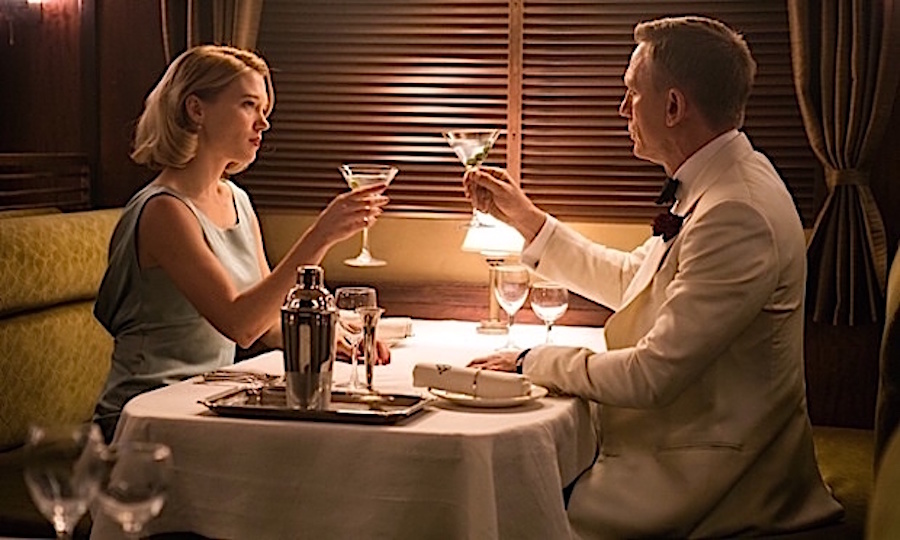
HAPPY SAINT VALENTINE'S DAY!
❖❖❖
IN THIS ISSUE
NEW ORLEANS
By Geoff Kalish
NEW YORK CORNER
MASTRO'S STEAKHOUSE
By John Mariani
NOTES FROM THE WINE CELLAR
The WINES OF JONATA AND THE HILT
By John Mariani
❖❖❖
NEW ORLEANS
By Geoff Kalish
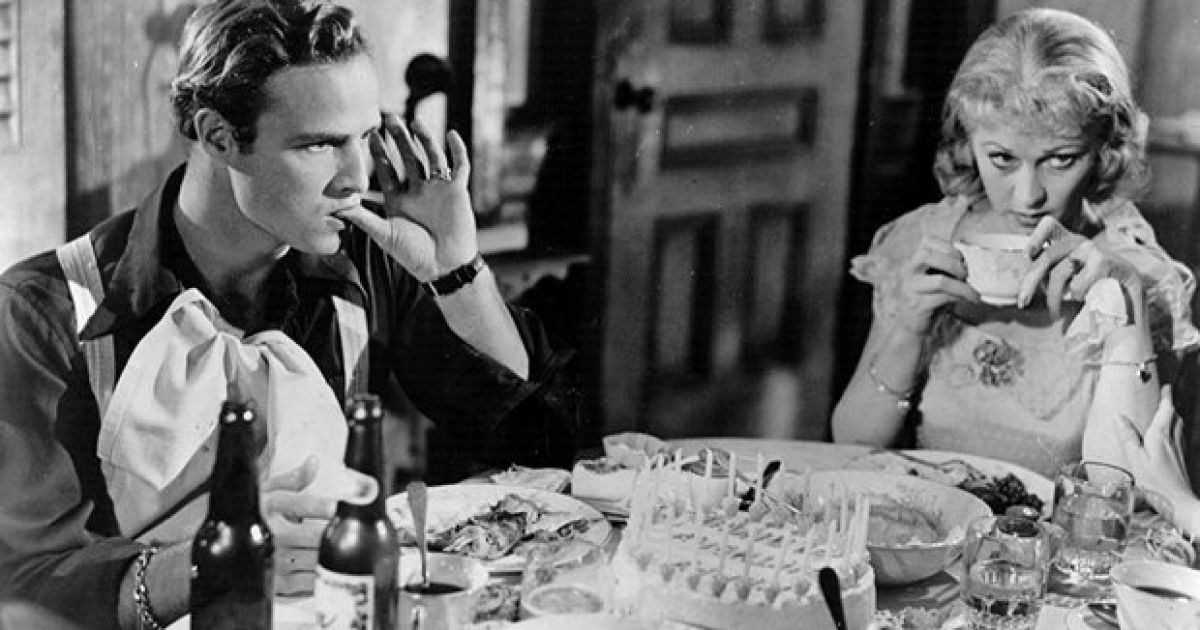
Based
on a recent visit, much in the historic areas of
downtown New Orleans has remained the same since
my last visit about a year after Hurricane
Katrina. Bourbon Street still looks and sounds
like Bourbon Street. 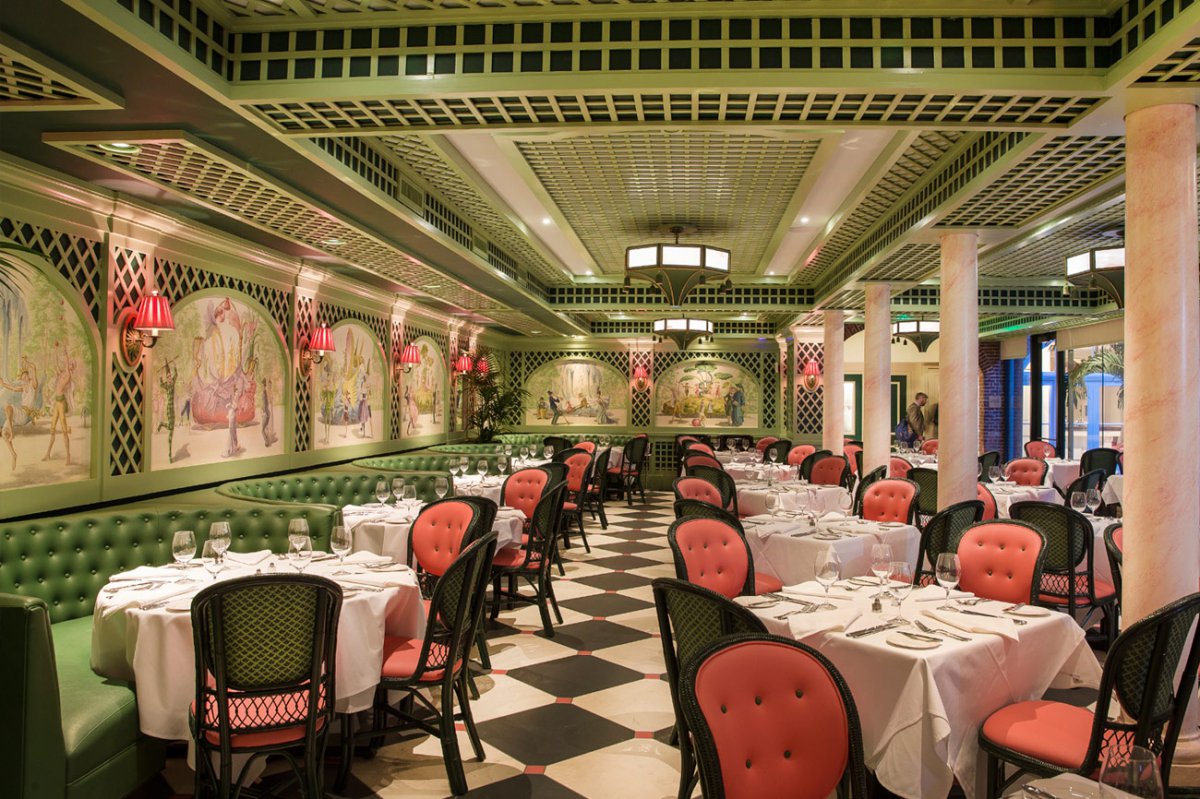 Galatoire’s
Friday lunch remains packed with partying
locals. Brennan’s
(left),
although under new ownership, still serves a
bevy of richly sauced egg dishes and decadent
Bananas Foster
from early morning through mid-afternoon in an
upscale setting. Café du Monde draws crowds all
hours of day and night for its chicory-laced
coffee and sugary beignets. The line for
breakfast at Mother’s still stretches down the
street with locals and visitors waiting for eggs
and “debris” (the shreds of meat and grease
falling off rotisserie roast beef), and Commander’s Palace
in the Garden District
Galatoire’s
Friday lunch remains packed with partying
locals. Brennan’s
(left),
although under new ownership, still serves a
bevy of richly sauced egg dishes and decadent
Bananas Foster
from early morning through mid-afternoon in an
upscale setting. Café du Monde draws crowds all
hours of day and night for its chicory-laced
coffee and sugary beignets. The line for
breakfast at Mother’s still stretches down the
street with locals and visitors waiting for eggs
and “debris” (the shreds of meat and grease
falling off rotisserie roast beef), and Commander’s Palace
in the Garden District  still draws an upscale
crowd.
still draws an upscale
crowd.
And as for lodging, there are
the usual French Quarter standbys like The Royal Orleans
and Royal
Sonesta as well as the plush, recently
refurbished Windsor
Court (right),
just across Canal Street from the French Quarter
and in easy walking distance to the Warehouse
District restaurants (see below), with a top-notch
restaurant of its own called the Dining Room,
featuring a beautiful room ringed with murals of
Louisiana lifestyle.
But much has changed. In
particular, the revitalization of the Central
Business District with restaurants and the
not-to-be-missed World War II Museum.
Housed in two separate buildings are a series of
rooms showing photos, movies and memorabilia of
the histories of the two theaters of operation
(Europe and the Pacific) that comprised WWII. Even
if you think you know all about “the war,” plan to
spend a few hours fascinated by the stories of the
campaigns.
On the dining scene,
even more has changed, especially so since I
co-authored the book The Best
Wining & Dining in New Orleans some 25
years ago. In particular, the once desolate
Warehouse District and Central Business District,
which used to be gourmet wastelands, are alive
with a range of toothsome eateries, two of which,
owned by celebrity chefs Donald Link and Stephen
Stryjewski, are discussed below.
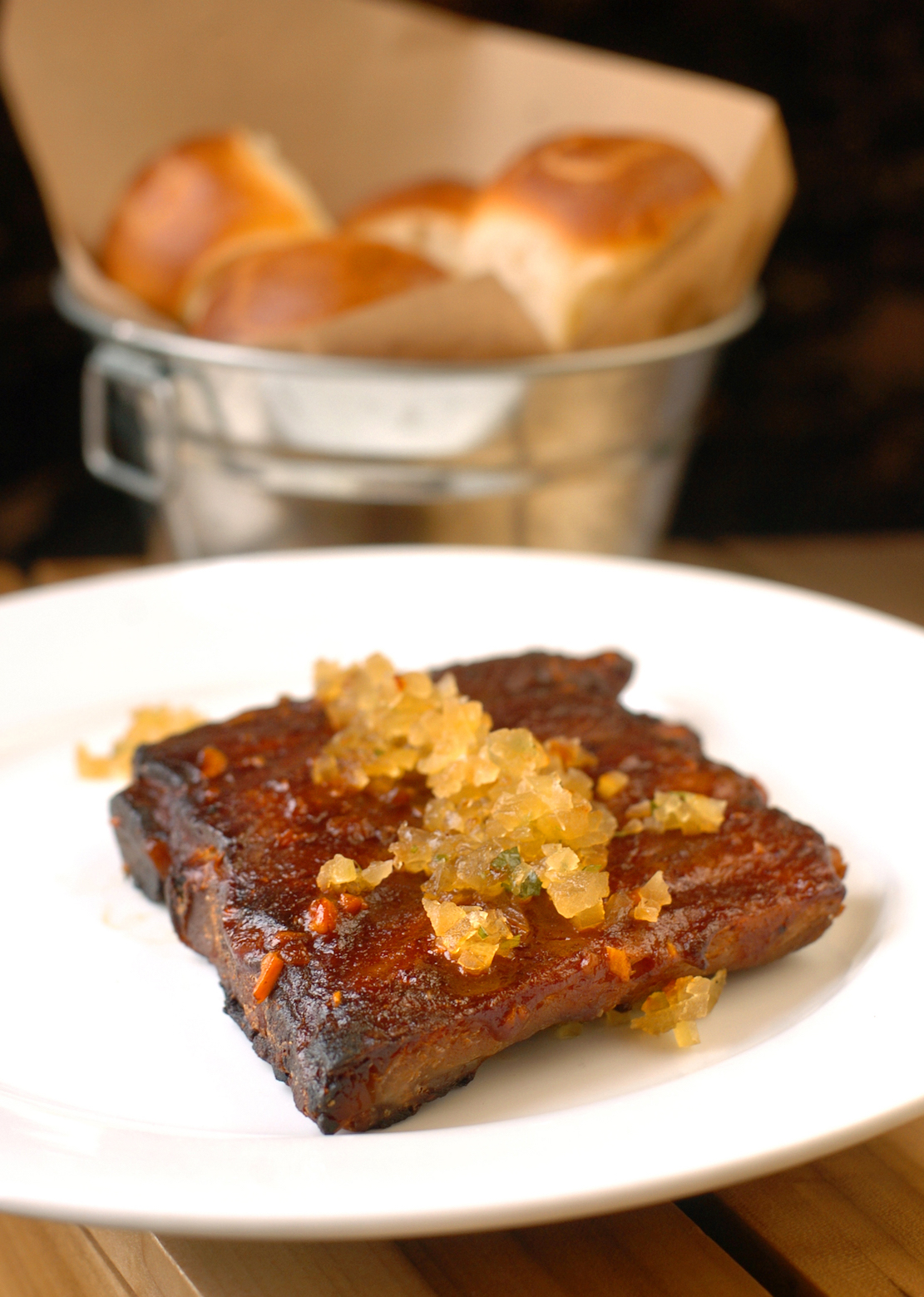 Cochon
Cochon
920 Tchoupitoulis Street
504-588-2123
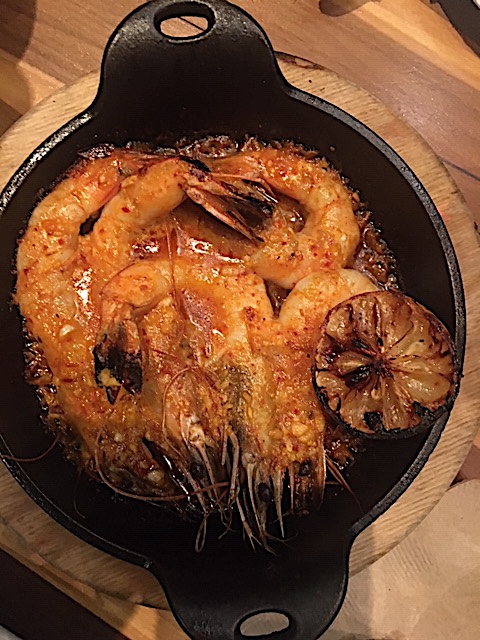 must-try starter of
smoked pork ribs (left) with watermelon pickle
brought four very meaty ribs, and a dish of
wood-fired shrimp with chili-garlic butter and
lemon held enough crustaceans that it could have
made a main course.
Other appetizers, like the heady roasted
duck and hot sausage gumbo or flavorful
port-braised pork cheek with pumpkin puree and
pistachio, also
provide hearty portions of tasty fare.
must-try starter of
smoked pork ribs (left) with watermelon pickle
brought four very meaty ribs, and a dish of
wood-fired shrimp with chili-garlic butter and
lemon held enough crustaceans that it could have
made a main course.
Other appetizers, like the heady roasted
duck and hot sausage gumbo or flavorful
port-braised pork cheek with pumpkin puree and
pistachio, also
provide hearty portions of tasty fare.
As to main courses, popular
choices include the classic Louisiana cochon,
shredded on a heap of cabbage and topped with
cracklin’s and accompanied by pickled turnips.
There are daily grilled gulf fish specials as well
as the smoked beef short rib with tomato butter
and mushrooms. Also, when available, be sure to
try a side of the heirloom carrots, prepared with
a mint sauce. For dessert an oatmeal tart had just
the right amount of sweetness and for wine, from a
short but well-thought-out list, we chose a 2016
Savigny-les-Beaune that had just the right amount
of cherry flavor and gusto to mate well with the
fare. And for the aficionado there’s long lists of
whisky and small-brewery beer choices, especially
bottles from Louisiana and nearby states.
(Expect
dinner for two to cost $100-$110, not including
wine, tax or tip.)
800 Magazine Street
504-522-1744
 What
Cochon does for the pig, Pêche, also owned by David Link,
does for denizens of the deep, again
in a refurbished warehouse with exposed walls and
wood-beamed ceiling, and, as one might expect, a
large painting of a fish on one wall. And,
while listed as a seafood restaurant in area
guides, the fare, prepared under the direction of
James Beard Award-winning chef Ryan Prewitt, is
quite a bit different from the simple seafood
houses of Louisiana. For example, a “raw bar”
starter of
What
Cochon does for the pig, Pêche, also owned by David Link,
does for denizens of the deep, again
in a refurbished warehouse with exposed walls and
wood-beamed ceiling, and, as one might expect, a
large painting of a fish on one wall. And,
while listed as a seafood restaurant in area
guides, the fare, prepared under the direction of
James Beard Award-winning chef Ryan Prewitt, is
quite a bit different from the simple seafood
houses of Louisiana. For example, a “raw bar”
starter of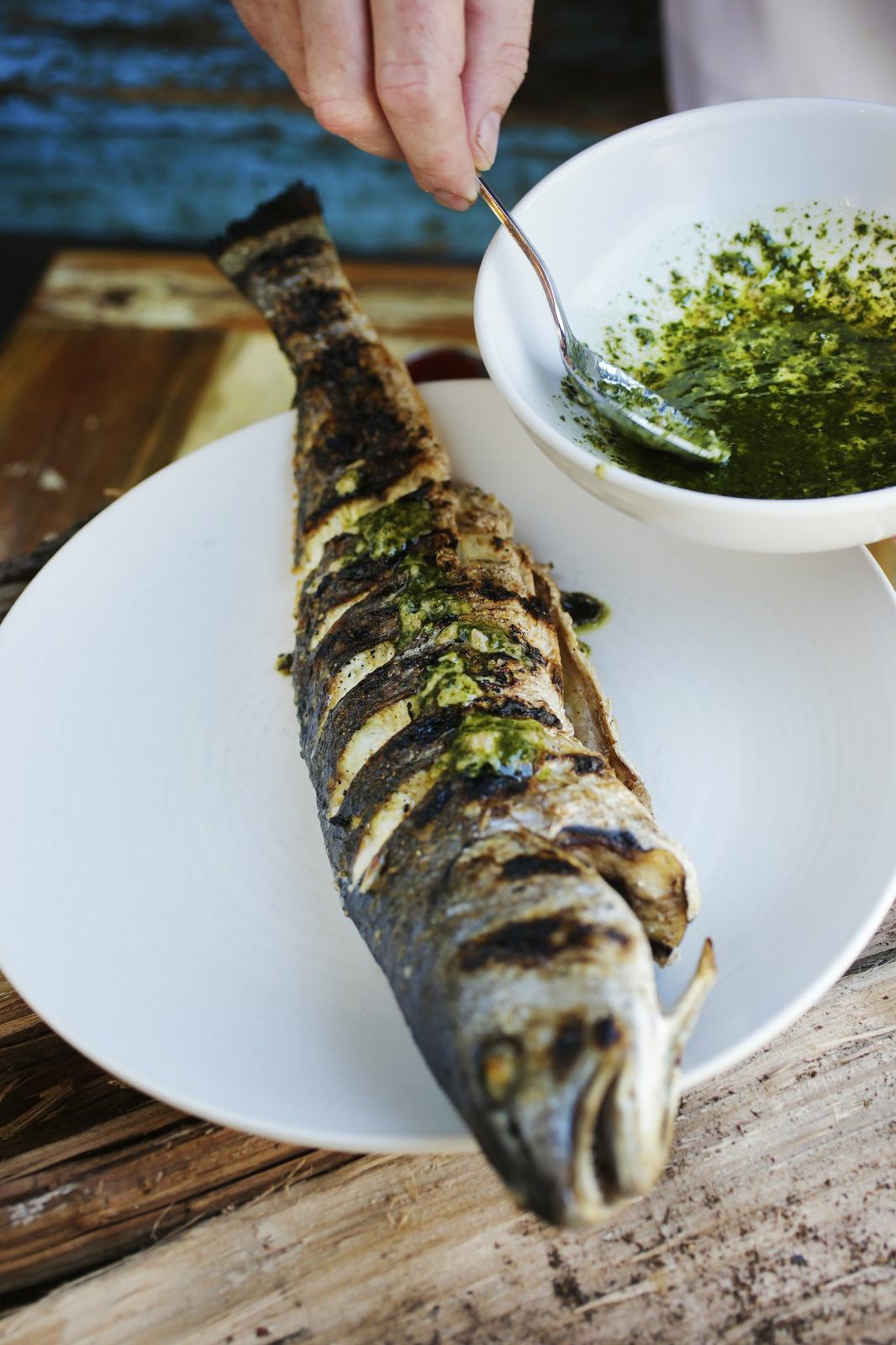 “crab
claws with pickled chiles” was a large bowl of
small, dewy claws swimming in a red-tinged sauce,
enlivened by jalapeño peppers. A creamy crab salad
topped with chives, apple slivers and toasted
pumpkin seeds came adrift in a sauce of chives and
African spices.
And, a moist, meaty grilled red fish for
two with a crisp skin coated with a savory parsley
and basil pesto, with a side of fried brussels
sprouts flavored with chili oil, was one of the
best dishes we had on our visit to the city. We
accompanied the meal with an appley, slightly
sweet Reinhessen Seehoff Riesling and for dessert,
from pastry chef Maggie Scales, we enjoyed a
generous slice of rich Key lime pie topped with
decadent Chantilly cream.
“crab
claws with pickled chiles” was a large bowl of
small, dewy claws swimming in a red-tinged sauce,
enlivened by jalapeño peppers. A creamy crab salad
topped with chives, apple slivers and toasted
pumpkin seeds came adrift in a sauce of chives and
African spices.
And, a moist, meaty grilled red fish for
two with a crisp skin coated with a savory parsley
and basil pesto, with a side of fried brussels
sprouts flavored with chili oil, was one of the
best dishes we had on our visit to the city. We
accompanied the meal with an appley, slightly
sweet Reinhessen Seehoff Riesling and for dessert,
from pastry chef Maggie Scales, we enjoyed a
generous slice of rich Key lime pie topped with
decadent Chantilly cream.
(Expect dinner for two to cost $65-$70, not
including wine, tax or tip.)
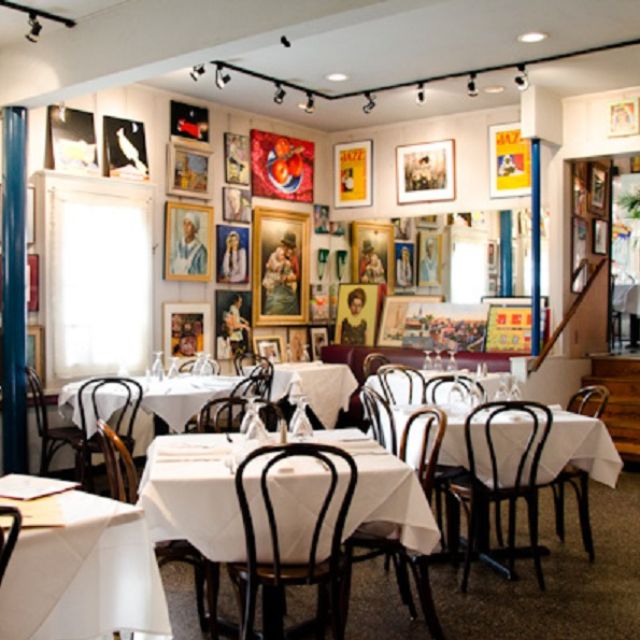 Upperline
Upperline
1413 Upperline Street
504-891-9822
Situated about a
15-minute car ride from the French Quarter,
Upperline has for more than 15 years been a local
favorite, serving huge portions of upscale
southern cooking on well-spaced, clothed tables in
one of three rooms that have yellow walls crammed
with paintings of different sizes and subjects.
Appetizers run the gamut from fried green tomatoes
with shrimp in a remoulade sauce that could have
shown a bit more zest, to spicy shrimp with
jalapeño corn bread and garlic aïoli that had plenty of
zest, to andouille and duck étouffée with
cornbread and Louisiana pepper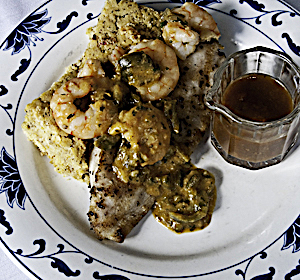 jelly, to a turtle soup
with sherry.
jelly, to a turtle soup
with sherry.
Main course items sampled
included a “12 hour” half roast duck that was
crisp on the outside and easily shreddable on the
inside, served with a garlic-Port sauce, and a
buttery baby drum fish meunière topped with fresh
jumbo lump crabmeat. Of note, pieces of a loaf of
good crusty bread were great to “mop up” the
sauces.
For dessert we had a rich pecan
bread pudding with toffee sauce and a sinful
“Sundae Eugene” (vanilla ice cream, almonds and
chocolate sauce). And we accompanied the meal with
a concentrated, berried Turley Lodi Zinfandel.
(Expect
dinner for two to cost a very reasonable
$80-$90, not including wine tax or tip.)
And,
if after all the eating, you need a few hours of
exercise away from the madding crowds, there’s
the Jack Nicklaus-designed English Turn
golf course (a 20-minute car ride from the
French Quarter), which for a long time was
considered one of the most challenging on the
PGA Tour. In fact, not only does the course
feature the classic elevated, undulating, tiered
greens surrounded by sand traps typical of a
Nicklaus course, but water comes into play on
almost all of the holes. And, while at over
7,000 yards from the “tips” it’s quite a
challenge for long hitters, the fairways are
wide enough to offer the average golfer an
enjoyable experience, with lots of local birds
watching most of your shots. (Green fees are a
very reasonable $60-$100 per player.)
❖❖❖
212-459-1222
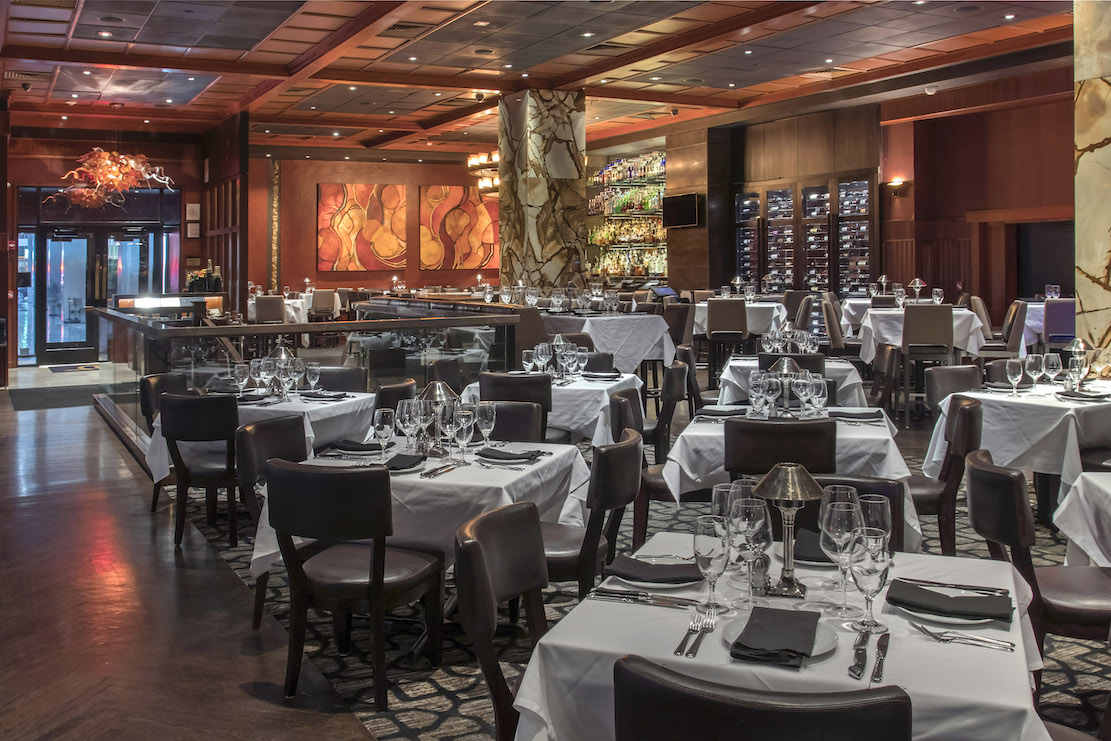
By John Mariani
Nowhere
is the competition fiercer in the restaurant
business than in the steakhouse genre, not
least because it’s difficult to distinguish
the menu from one to the next whose clientele
doesn’t really care if a chef puts chopped
kale on his ribeye or quinoa on his baked
potato. The template for the American
steakhouse is by no means sacrosanct but it
hews to a set pattern. So what’s left to
distinguish one from the next is décor,
quality of products and service.
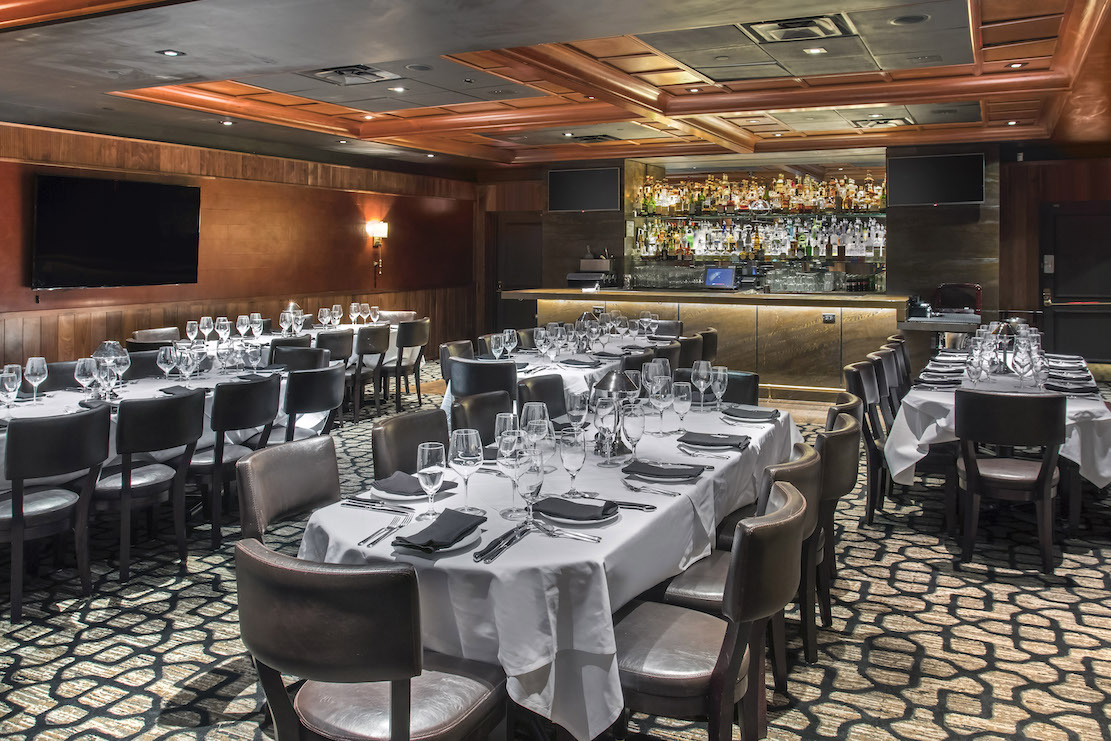 The first of those
offers the easiest way to make a distinction,
for the outdated scruffy, wainscotted look set
decades ago by places like The Palm and Peter
Luger has almost disappeared in lieu of grander
schemes. The second, quality of products, is
almost a given in New York—though not outside of
it. The best beef and seafood is still sold to a
New York market willing to pay the highest
price, so one steakhouse’s beef and lobster
better be every bit as good as the other’s
(although this isn’t always the case all the way
down the menu). Third, service is a true
identifier, especially in New York, where the
old-line steakhouses deliberately proffer a
1960s clubbish swagger that just doesn’t cut it
anymore.
The first of those
offers the easiest way to make a distinction,
for the outdated scruffy, wainscotted look set
decades ago by places like The Palm and Peter
Luger has almost disappeared in lieu of grander
schemes. The second, quality of products, is
almost a given in New York—though not outside of
it. The best beef and seafood is still sold to a
New York market willing to pay the highest
price, so one steakhouse’s beef and lobster
better be every bit as good as the other’s
(although this isn’t always the case all the way
down the menu). Third, service is a true
identifier, especially in New York, where the
old-line steakhouses deliberately proffer a
1960s clubbish swagger that just doesn’t cut it
anymore.
And here’s where Mastro’s,
one of 18 units around the U.S., has a strong
suit. Mastro’s is a subsidiary of the gargantuan
Landry’s Inc., which also owns the Morton’s and
Del Frisco steakhouse chains, both with units in
New York. At Mastro’s the “How we all doing
tonight?” greeting through the “Hope to see you
again soon” goodbye work wonders throughout an
evening—unlike so many steakhouses where the
waiters know they’re going to make their $500 in
tips every night without doing anything more
than take your order and the slicked-up guys up
front are getting their palms well greased.
Mastro’s
décor is swanky by any stretch, set on two
levels, very low-lighted—it’s considerably
darker than in the photo above—with bars made  of
bronze satin quartzite, dark mahogany woodwork,
stained wood flooring, marble columns, piano
stand and trompe l'oeil patterns set within the
floors and walls. The tables are spacious and
well set with white linens and lamps, though the
wineglasses are cheap. It gets a mostly male
clientele whom the shabbily dressed food media
ding with the lazy cliché “suits” (just imagine
if they dared call business women “skirts”). In
any case, the men all doff their jackets within
seconds of sitting down, deferring to their host
of the evening, who decides if a bottle of wine
is in the budget.
of
bronze satin quartzite, dark mahogany woodwork,
stained wood flooring, marble columns, piano
stand and trompe l'oeil patterns set within the
floors and walls. The tables are spacious and
well set with white linens and lamps, though the
wineglasses are cheap. It gets a mostly male
clientele whom the shabbily dressed food media
ding with the lazy cliché “suits” (just imagine
if they dared call business women “skirts”). In
any case, the men all doff their jackets within
seconds of sitting down, deferring to their host
of the evening, who decides if a bottle of wine
is in the budget.
One big caveat: In a city of
very loud restaurants, dining upstairs at
Mastro’s can be ear-shattering, not helped by
live and piped-in music. Downstairs (above),
where I requested to sit, was better, and there
is a small room at the bottom of the stairs that
is most likely to allow for conversation.
For the volume Mastro’s
does—an average 300 meals a night— Executive
Chef Dusmane Abdoulaye Tandia works like a field
marshal, and, although there were some lags
between courses on a recent night, the food came out at the right
temperature, the plates for the meats hot and
the choreography of waiters, runners and busboys
impressive as dishes are carved, scooped and
plated with precision.
came out at the right
temperature, the plates for the meats hot and
the choreography of waiters, runners and busboys
impressive as dishes are carved, scooped and
plated with precision.
The staff promotes the
two-foot-tall tower of seafood, whose contents
you create yourself, and the seafood arrives
dramatically in billowing dry ice (right). Nice,
fat shrimp ($26) were, happily, not ice
cold, and the crab cake ($21) was meaty and came
with a well-seasoned remoulade. Fried calamari
were about standard issue, but a lobster bisque
($17) had a wonderful depth of flavor and lots
of chunks of lobster (which many bisques simply
don’t have).
The 33-ounce
ribeye on the bone ($115) had an excellent char
on the outside and stayed good and hot and rosy
red on the inside. 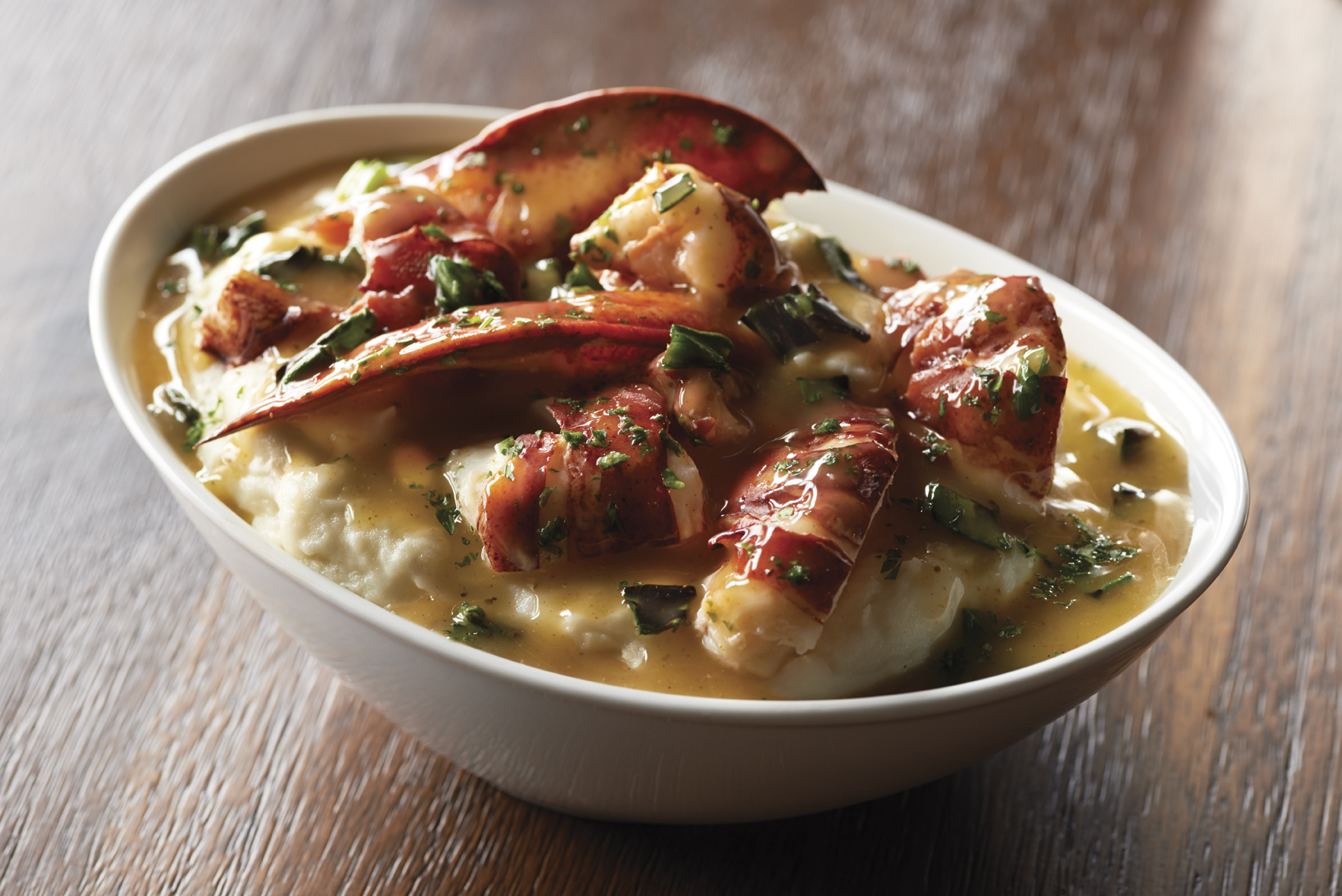 It’s
advertized for two, but our table of four
enjoyed several pieces each and still took some
home. Lamb chops ($54) were of good quality for
Australian product, but at that price, and more
in keeping with excellence, Mastrio’s should be
serving American lamb. The veal chop ($64) had a
rich flavor not always found elsewhere, and its
succulence showed again that the kitchen has the
matter down pat. There is a tendency to oversalt
the meats, however.
It’s
advertized for two, but our table of four
enjoyed several pieces each and still took some
home. Lamb chops ($54) were of good quality for
Australian product, but at that price, and more
in keeping with excellence, Mastrio’s should be
serving American lamb. The veal chop ($64) had a
rich flavor not always found elsewhere, and its
succulence showed again that the kitchen has the
matter down pat. There is a tendency to oversalt
the meats, however.
The creamed spinach ($14) was
a good balance of the two ingredients, but a big
portion of scalloped potatoes ($14) lacked much
flavor beyond the potatoes themselves.
You know desserts are going
to be huge—two for four people after a big meal
are quite enough—including a good New York
cheesecake ($12), tangy Key lime pie ($11) and
textbook perfect crème brûlée ($11).
Mastro’s wine
list is in a league with the best around town
and shares the heavy-handed price calculation
that makes a red wine under $100 difficult to
find, and wines by the glass are exorbitantly
priced.
(Having praised the service,
I cannot fail to mention that at the end of the
meal two $9 bottles of water showed up on my
bill that I did not order. Caveat everywhere: Always
check your bill.)
Open daily for lunch and dinner.
❖❖❖
ARE AMONG THE CHALLENGES AT JONATA
By John Mariani
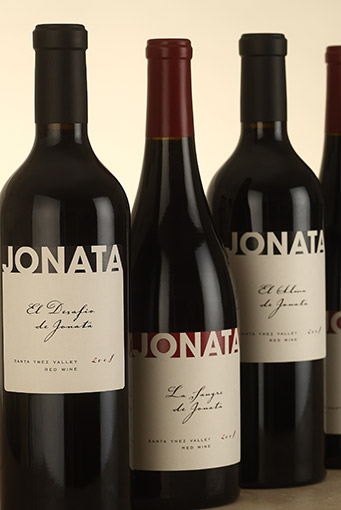
Nature
has not made it easy for the JONATA wineries.
The estate in Ballard Canyon is a 586-acre
property of sandy soil, with 84 acres of vines,
including more than 11 different varieties
planted, along with high-acid experimental Greek
plantings like Xinomavro and Assyrtiko. The
Hilt estate in the Central Coast’s Santa
Rita Hills focuses on Chardonnay and Pinot Noir
in vineyards bathed in fog and whose
north-facing slopes approach 45-degree
temperatures and 50 mph winds, terroir that
winemaker Matt Dees refers to as “growing in the
margins.”
 Joining JONATA in 2004
when he was just 25, Dees (left) was not
an enologist but had instead studied plant
sciences far from any vineyards at the University
of Vermont. His youthful exuberance was key to
JONATA/The Hilt’s unorthodox experiments in that
marginal terroir, but after 15 years on the job,
the boyish-looking Dees is as devoted as ever to
go rogue in the vineyards. I dined with him in New
York and found him gleeful when speaking about all
his projects, as if Tom Swift Jr. had carte
blanche to create a Super Vineyard.
Joining JONATA in 2004
when he was just 25, Dees (left) was not
an enologist but had instead studied plant
sciences far from any vineyards at the University
of Vermont. His youthful exuberance was key to
JONATA/The Hilt’s unorthodox experiments in that
marginal terroir, but after 15 years on the job,
the boyish-looking Dees is as devoted as ever to
go rogue in the vineyards. I dined with him in New
York and found him gleeful when speaking about all
his projects, as if Tom Swift Jr. had carte
blanche to create a Super Vineyard.
“We are ten miles east of the
ocean, so the area is colder than in the north,”
he said. “It never gets warmer than 80 degrees,
whereas it can go up to 110 in Napa.” Dees noted
that the region of JONATA has sandy maritime soil
(called Careaga Sandstone) and showed me photos of
how small his vineyards’ grapes are by comparison
with the sun-drenched, sugar-plump grapes in Napa
and Sonoma. The Hilt’s diatomaceous soil, by
comparison, is like lunar dust. Yet, despite
mis-steps and outright flops along the way—three
successive vintages of Merlot ranged from mediocre
to poor—Dees has had total freedom to keep on
experimenting. The high acid Greek wines are a
current infatuation, but he has no plans to
release any unless they work in the Santa Barbara
terroir.
Such largess is rare, if not
unique, in the California wine business, where
very wealthy people often lavish more money on
their country mansions than their vineyards. In
the case of JONATA, carte blanche, rather than
conventional wisdom, seems a mantra, thanks to
owner Stan Kroenke and his wife, Ann, daughter of
Walmart co-founder James Walton (right), whose
business empire includes Kroenke Sprits &
Entertainment, a holding company for the NFL’s
L.A. Rams, the English Premier League football
club Arsenal, the NBA’s Denver Nuggets, the NHL’s
Colorado Avalanche, the MLS Colorado Mammoth and
the LA Gladiators. He is also owner of Napa
Valley’s prestigious Screaming Eagle winery, and The Land Report magazine ranked him
as the ninth-largest landowner in the U.S. in
2015. In 2018 Stan Kroenke was estimated
by Forbes
to be worth $8.5 billion.
The name JONATA commemorates
the original 1845 Spanish land grant of the
region, Rancho San Carlos de Jonata, which in the
Chumash Indian language means “tall oak.”
For all that ongoing push to
try new projects, the 2017 The Hilt Chardonnay
($45) is for me a superb expression of a varietal
that in California is so often over-oaked,
over-caramelized and overwrought. It’s a blend
from three barrels, and the symmetry of fruit and
acid, a 13.4% alcohol level and aging in 40% new
French oak gives it roundness and body, as
expressive of healthy Chardonnay grapes as you’d
find in the best traditional Burgundies. The
single-vineyard
Bentrock Vineyard Chardonnay ($75), while a
little pricey, has an even richer flavor and
complexity, making it a superb match for shellfish
in buttery sauces.
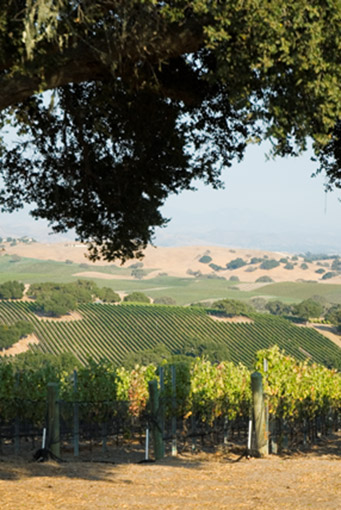 I
was not as fond of The Hilt’s 2017 Pinot Noir
($45), which I found had an odd, green vegetal
flavor, but the 2017 Radian Vineyard Pinot Noir
($75) was a beauty, aged in only 5% new French oak
and 95% neutral French oak, which allows the grape
flavors to evolve with minimal interference. It’s
a superb Pinot Noir at a reasonable
price.
I
was not as fond of The Hilt’s 2017 Pinot Noir
($45), which I found had an odd, green vegetal
flavor, but the 2017 Radian Vineyard Pinot Noir
($75) was a beauty, aged in only 5% new French oak
and 95% neutral French oak, which allows the grape
flavors to evolve with minimal interference. It’s
a superb Pinot Noir at a reasonable
price.
Over dinner I also tasted two
library releases that showed how the JONATA wines
can mature so gracefully over a decade, a grace
that over-extracted California Pinots never
achieve. The
2010 El Desafio de Jonata “The Defiance” Cabernet
Sauvignon Ballard Canyon (whose name must set a
record for its length) is made from grapes out of
the best of the estate’s lots, coming in at 14.5%
alcohol. There are tannins still waiting to tame
down, but the whole amalgam is a wine of luscious
ripeness without being cloying in any way. It’s
got plenty of years ahead to get better.
The 2006 “The Blood” Syrah from
Ballard Canyon (left)
has a delightful, peppery quality and an intensity
you expect from Syrah, with only 2% Viognier
added. It aged in 50% new French oak and 50%
neutral, which complements the big fruit flavors.
At 14.9% it’s skirting the stratosphere for
alcohol but that’s not out of bounds for a big
Syrah like this. A JONATA Todos Santa Ynez Valley
2016 tilts that way, too, as a blend of all ten
different varietals grown on the whole estate,
which was not a convincing argument for a repeat.
JONATA Fenix Ballard Canyon
2016, a Bordeaux-style blend of 58% Merlot, 30%
Cabernet Sauvignon, 10% Cabernet Franc and 2%
Petit Verdot, weighs in at 15.2% alcohol, which
can be felt on first sip. The wine is not
translucent, the color is inky and the plummy
flavor not appealing. Back to the lab with this
one.
It goes without
saying that the Kroenkes and Dees are wholly
committed to sustainability—herbicides and
pesticides are banned—utilizing what is called
polyface farming by which viticulture co-exists
and integrates with agriculture (they make their
own honey and grow olives) as well as with
livestock. Having acquired hundreds of chickens,
they’d forgotten that hens lay lots of eggs and
the estate now sells their production in the area.
There are pigs, turkeys, sheep and goats, even a
couple of mean-spirited llamas.
“People bring us animals and
others think we’re a petting zoo,” said Dees.
“It’s a pretty wonderful place to work.”
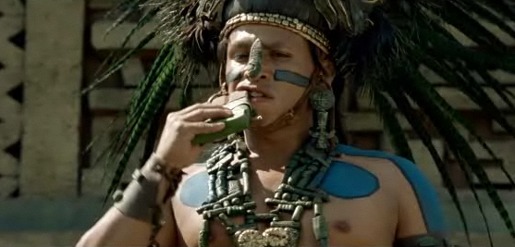 NEATEST
TRICK OF THE WEEK:
NEATEST
TRICK OF THE WEEK:
ANCIENT MAYAN RECIPES MADE WITH FOODS THEY
DIDN'T EAT, LIKE BRISKET, CHICKEN AND RICE
“But true
nourishment awaits inside, in steaming bowls born of
ancient Mayan recipes. . . . The ruddy
tomato-based hilachas features hearty
shreds of brisket, creamy chunks of carrot and
potato, green beans, and rice. The green jocón pairs the same
vegetables with chicken instead of beef, and
bathes them in a complexly layered broth, bright
with tomatillo and cilantro.”--Hannah Goldfield, “Warming
Up Guatemalan Style in Brooklyn,” The New Yorker
(1/3/20)

OR
ARE YOU GLAD TO SEE ME?
"Ahead of Telfar’s autumn/winter 2020 show at Florence’s Pitti Uomo (a trade show for men’s fashion), an extravagant feast was held in the Palazzo Corsini for friends of the brand, where diners were treated to an unexpected palate cleanser: 'edible ball gags,' Sicilian pomelo-infused spherical ice pops cut through with a black leather ribbon to be placed in the mouth and tied behind one’s head. . . . Appetizers like miso semifreddo with fermented yuzu rind and wild Madagascar pepper were fed to diners via latex-gloved hands that emerged from a glory hole installation; they kneeled to receive the food."--"If You Eat This Food, It Will Deconstruct Your Toxic Masculinity," Eater.com.
❖❖❖
Any of John Mariani's books below may be ordered from amazon.com.
 The Hound in Heaven
(21st Century Lion Books) is a novella, and
for anyone who loves dogs, Christmas, romance,
inspiration, even the supernatural, I hope you'll find
this to be a treasured favorite. The story
concerns how, after a New England teacher, his wife and
their two daughters adopt a stray puppy found in their
barn in northern Maine, their lives seem full of promise.
But when tragedy strikes, their wonderful dog Lazarus and
the spirit of Christmas are the only things that may bring
his master back from the edge of despair.
The Hound in Heaven
(21st Century Lion Books) is a novella, and
for anyone who loves dogs, Christmas, romance,
inspiration, even the supernatural, I hope you'll find
this to be a treasured favorite. The story
concerns how, after a New England teacher, his wife and
their two daughters adopt a stray puppy found in their
barn in northern Maine, their lives seem full of promise.
But when tragedy strikes, their wonderful dog Lazarus and
the spirit of Christmas are the only things that may bring
his master back from the edge of despair. WATCH THE VIDEO!
“What a huge surprise turn this story took! I was completely stunned! I truly enjoyed this book and its message.” – Actress Ali MacGraw
“He had me at Page One. The amount of heart, human insight, soul searching, and deft literary strength that John Mariani pours into this airtight novella is vertigo-inducing. Perhaps ‘wow’ would be the best comment.” – James Dalessandro, author of Bohemian Heart and 1906.
“John Mariani’s Hound in Heaven starts with a well-painted portrayal of an American family, along with the requisite dog. A surprise event flips the action of the novel and captures us for a voyage leading to a hopeful and heart-warming message. A page turning, one sitting read, it’s the perfect antidote for the winter and promotion of holiday celebration.” – Ann Pearlman, author of The Christmas Cookie Club and A Gift for my Sister.
“John Mariani’s concise, achingly beautiful novella pulls a literary rabbit out of a hat – a mash-up of the cosmic and the intimate, the tragic and the heart-warming – a Christmas tale for all ages, and all faiths. Read it to your children, read it to yourself… but read it. Early and often. Highly recommended.” – Jay Bonansinga, New York Times bestselling author of Pinkerton’s War, The Sinking of The Eastland, and The Walking Dead: The Road To Woodbury.
“Amazing things happen when you open your heart to an animal. The Hound in Heaven delivers a powerful story of healing that is forged in the spiritual relationship between a man and his best friend. The book brings a message of hope that can enrich our images of family, love, and loss.” – Dr. Barbara Royal, author of The Royal Treatment.
 |
The Encyclopedia of American Food and Drink by John F. Mariani (Bloomsbury USA, $35) Modesty forbids me to praise my own new book, but let me proudly say that it is an extensive revision of the 4th edition that appeared more than a decade ago, before locavores, molecular cuisine, modernist cuisine, the Food Network and so much more, now included. Word origins have been completely updated, as have per capita consumption and production stats. Most important, for the first time since publication in the 1980s, the book includes more than 100 biographies of Americans who have changed the way we cook, eat and drink -- from Fannie Farmer and Julia Child to Robert Mondavi and Thomas Keller. "This book is amazing! It has entries for everything from `abalone' to `zwieback,' plus more than 500 recipes for classic American dishes and drinks."--Devra First, The Boston Globe. "Much needed in any kitchen library."--Bon Appetit. |
"Eating Italian will never be the same after reading John Mariani's entertaining and savory gastronomical history of the cuisine of Italy and how it won over appetites worldwide. . . . This book is such a tasteful narrative that it will literally make you hungry for Italian food and arouse your appetite for gastronomical history."--Don Oldenburg, USA Today. "Italian
restaurants--some good, some glitzy--far
outnumber their French rivals. Many of
these establishments are zestfully described
in How Italian Food Conquered the World, an
entertaining and fact-filled chronicle by
food-and-wine correspondent John F.
Mariani."--Aram Bakshian Jr., Wall Street
Journal.
"Equal parts
history, sociology, gastronomy, and just
plain fun, How Italian Food Conquered the
World tells the captivating and delicious
story of the (let's face it) everybody's
favorite cuisine with clarity, verve and
more than one surprise."--Colman Andrews,
editorial director of The Daily
Meal.com. "A fantastic and fascinating
read, covering everything from the influence
of Venice's spice trade to the impact of
Italian immigrants in America and the
evolution of alta cucina. This book will
serve as a terrific resource to anyone
interested in the real story of Italian
food."--Mary Ann Esposito, host of PBS-TV's
Ciao
Italia. "John Mariani has written the
definitive history of how Italians won their
way into our hearts, minds, and
stomachs. It's a story of pleasure over
pomp and taste over technique."--Danny Meyer,
owner of NYC restaurants Union Square
Cafe, The Modern, and Maialino.
|
 |
 |
 |
 |
 |
 |
 |
 |
 Everett Potter's Travel Report:
Everett Potter's Travel Report: 
 Eating Las Vegas
JOHN CURTAS has been covering the Las Vegas
food and restaurant scene since 1995. He is
the co-author of EATING LAS VEGAS – The 50
Essential Restaurants (as well as
the author of the Eating Las Vegas web site: www.eatinglasvegas.
He can also be seen every Friday morning as
the “resident foodie” for Wake Up With the
Wagners on KSNV TV (NBC) Channel 3 in
Las Vegas.
Eating Las Vegas
JOHN CURTAS has been covering the Las Vegas
food and restaurant scene since 1995. He is
the co-author of EATING LAS VEGAS – The 50
Essential Restaurants (as well as
the author of the Eating Las Vegas web site: www.eatinglasvegas.
He can also be seen every Friday morning as
the “resident foodie” for Wake Up With the
Wagners on KSNV TV (NBC) Channel 3 in
Las Vegas.
MARIANI'S VIRTUAL GOURMET
NEWSLETTER is published weekly. Publisher: John Mariani. Editor: Walter Bagley. Contributing Writers: Christopher Mariani,
Robert Mariani, Misha Mariani, John A. Curtas, Gerry Dawes, Geoff Kalish,
and Brian Freedman. Contributing
Photographer: Galina Dargery. Technical
Advisor: Gerry
McLoughlin.
If you wish to subscribe to this
newsletter, please click here: http://www.johnmariani.com/subscribe/index.html
© copyright John Mariani 2020

